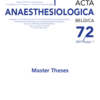Pitfalls and benefits of virtual reality hypnosis during transcatheter aortic valve implantation in high risk patients
Transcatheter aortic valve replacement; virtual reality; hypnosis
Published online: Apr 21 2022
Abstract
Background: in high risk patients unfit for cardiopulmonary bypass and general anaesthesia (GA), Transcatheter Aortic Valve Implantation (TAVI) with local anaesthesia and conscious sedation (LACS) is an approved alternative. Further reduction of sedatives benefits complication rate, length of stay and patient satisfaction. Several non-pharmacological strategies were proposed in other domains, of which virtual reality hypnosis (VRH) is increasingly popular. Our goal was to evaluate recent VRH implementation in our TAVI protocol for patients with high anxiety levels.
Methods: an ethical approved retrospective chart review of TAVI care at Antwerp University Hospital, Belgium was performed. All femoral TAVI procedures (N=81) between 2019 and 2021 were included and anonymized data was compared in three groups (GA, awake and VRH).
Primary objectives were: 30-day mortality, postoperative valve function (regurgitation, mean and maximum LV-Ao gradient), vascular complications, conduction disorders, pacemaker implantation, procedural time and length of stay. Pitfalls compromising future prospective research were identified (secondary outcome).
Results & Discussion: an overview of our current care was established. Primary outcome parameters showed no differences except for reduced procedure time in awake and VRH groups. VRH implementation in our TAVI protocol showed no harm and can be seen as a save alternative for sedation. Periprocedural observations showed that by interrupting visual and auditory VR input, a hypnotic dissociative state was not reached or maintained. Painful TAVI sheath introduction and rapid pacing related nausea was suppressed insufficiently in some cases.
Conclusion: VRH implementation in our TAVI protocol is safe. This trial led to an updated approach for improved procedure time, patient satisfaction and procedural outcome. A prospective study is ready to be launched. This will not only benefit future standard care in high risk patients, but also in medium and low risk patients.
